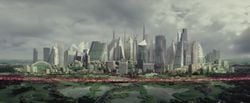Element 120.V
From Halopedia, the Halo wiki
Element 120.V[1] was a substance created during the Battle of Installation 04. It was later employed as part of a weapon of mass destruction during the Terrorist attack on Sedra City in 2556.[2]
Characteristics
Creation
- "It's not a compound, an element. The closest they can pin it is the 120 family but with a transmutation of some sort that makes it something no one's ever seen."
- — Gregory Ramos on the element.
During the Battle of Installation 04, John-117 detonated the Fusion reactors of the UNSC Pillar of Autumn, igniting a massive "supernova-level" explosion that resulted in the creation of a new element, Element 120.V. The destruction of the ring formed several pieces of debris including the Alpha Shard. While the majority of the installation's debris burned up in the atmosphere of Threshold, the Alpha Shard initiated an emergency slipspace jump, ending up in a decaying orbit around a star. A later scan of the Alpha Shard showed traces of the element there, but nowhere else in the universe.[2]
Weapon
- "This is radiological, some sort of designer agent."
- — -Laura Daoud[3]
During the attack on Sedra, the element was capable of being used in the creation of a bomb targeting humans at a genetic level.[4] The blast initiated when the weaponised version of the element was used affected humans up to 8-10km away from the epicentre of the blast.[2] When detonated, the weapon caused a minor seismic event in the Sedra City market[5][6], and irradiated those in the surrounding area with up to 4 grays of radiation.[6] The pulse emitted by the weapon as a red pulse, spreading away from the origin point of the blast.[2]
The weapon randomly compromises human DNA, but not that of other species.[2] Exposure to the substance would affect the blood cells' ability to divide normally, until the heart is pumping "poison" all over the human body.[3] This would usually manifest itself as the veins in the body turning black, with at least one person "bleeding from the face".[5] However, symptoms would depend on exposure and distance from the epicentre of the attack due to the element's short half-life, though it was noted that anyone who had recieved more than 3 grays of radiation would experience grave effects no matter what the exposure to the agent was.[6] All affected to a mortal level would die within fourteen hours, with no survivors.[6] The weapon's short half-life also made studying it difficult, as every time infected organic matter was taken out of stasis for examination, it would decay more.[3]
The weapon's effects were noted as being distinctly similar as those exhibited by firing the Halo Array.[3]
Storage
Element 120.V was stored in a null state stasis container, roughly 10 cubic meters in volume. The case was noted as being bulletproof and "zero energy state", with no energy or atomic movement inside.[7] The container would be capable of preventing both Hawking radiation and Gamma radiation from penetrating it.[8] During the attack itself, however, the weapon was deployed in a small spherical container.[2]
Usage
The element was mined from the Alpha Shard and used during the Terrorist attack on Sedra City in February 2556. Initially, the weapon was identified as a bioweapon, though later study clarified it to not be virus, a "unknown", or anything conventionally infectious.[3] Due to the element's source being the Alpha Shard alone, a mission was devised to detonate a HAVOK tactical nuclear weapon on the site and annihilate it, ensuring that no more samples of the weapon could be built.[2]
Disrepancies
The element is first identified as being in The "120 range" in Halo: Nightfall, and later specified as Element 121 on the hologram while the characters are searching for its source. In a later Canon Fodder issue[1], the element is identified as Element 120.V, which is used as the article title on this page. However, the element having an atomic number as high as 120 makes little sense, as heavy elements typically have extremely short half-lives, decaying almost as soon as they are formed. As a result, heavy elements such as 120 cannot exist as stable atoms naturally, leaving the question of how the element is supposedly able to exist as a substance capable of being mined dubious.
To further add to this mystery, the element is noted as being created specifically when the Pillar of Autumn had its reactor destroyed in Halo: Combat Evolved, which created a "supernova-level event" that destroyed Installation 04. Supernovae are a natural part of a stellar life cycle, and are responsible for the creation of most elements found in space due to the fusion going on in the star's last moments leading up to its collapse. Why this fusion reaction created Element 120 while no other fusion reactions in the universe did also remains a mystery, as does the UNSC's ability to scan the entire known universe in a matter of minutes for traces of the element. However, it's possible that it's creation was a combination of the supernova-level event and the properties of Installation 04 itself as part of the Halo Array.
Throughout Halo: Nightfall, the weapon is repeatedly referred to as a bioweapon. However, the Halo: Nightfall Second Stories later clarify it is not a bioweapon, but a radiological one.
List of appearances
- Halo: Nightfall (First appearance)
- Halo Mythos
Sources
- ^ a b Halo Waypoint: Canon Fodder 2/26/2015: Issue 13 Second to None
- ^ a b c d e f g Halo: Nightfall
- ^ a b c d e Halo: Nightfall: ONI: Unit 54
- ^ Halo Mythos: A Guide to the Story of Halo
- ^ a b Halo: Nightfall: Exposure
- ^ a b c d Halo: Nightfall: ONI: Compliance
- ^ Halo: Nightfall: Outbound Cargo - Part 1
- ^ Halo: Nightfall: Outbound Cargo - Part 2

